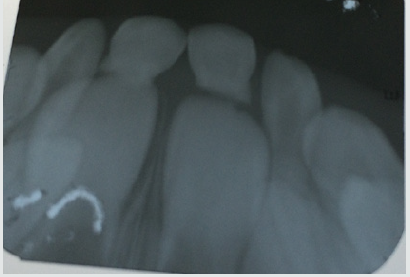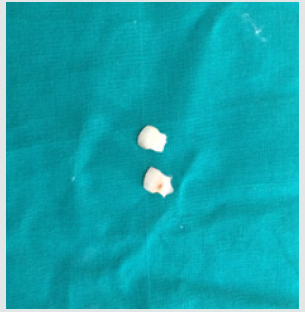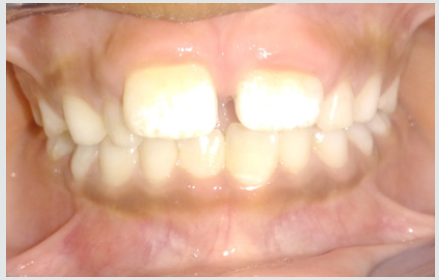Lupine Publishers | Journal of Pediatric Dentistry
Abstract
This article provides an overall review of the indications and safety of paediatric dental procedures performed under general anaesthesia. This pharmacological management of children with anxiety, systemic health considerations and special needs in a controlled hospital setting facilitates the provision of safe and effective treatment with successful outcomes.
Introduction
The relationship between an infant, child or an adolescent patient and a dentist is very important because this interaction influences the life of a child outside a dental surgery. Dental treatment requires an understanding of a child at their level of development since they differ in their personality, cognitive ability, motor skills, language milestones, fears and experience of life and pain. The three basic temperaments which may influence a child are classified as easy, difficult and slow to warm up. A child with an easy temperament is flexible. Children with a difficult temperament respond best to confidence whereas children who are slow to warm up require patience and sensitivity. A variety of approaches and techniques may be therefore be employed by the dental team to inform and communicate with a child for the purpose of structuring their behavior with a child [1,2]. A safe and effective pain control in children and adolescents employs over lapping categories of behavioral techniques, local anaesthesia (LA), conscious sedation and general anaesthesia (GA). Selection of the most optimum management in a child is influenced by the cognitive ability, medical status and the complexity of the dental procedure [3,4].
Pharmacological Behaviour Management in Children
Children perceive pain according to their stage of cognitive development. Management of pain and anxiety in a child is an integral component of paediatric dentistry. Hence the behaviour management skills for this purpose include communication, empathy, active listening, coaching, tolerance and flexibility. Recent trends indicate an increasing use of general anaesthesia for pharmacological pain and anxiety management in paediatric dentistry. The indications for dental treatment under GA include restoration of carious teeth, endodontic treatment in caries or trauma, prophylactic scaling to prevent periodontal pathology, exposure of ectopic teeth, removal of supernumeraries, extraction or removal of permanent molars, clearance of unrestorable asymptomatic teeth and extractions for balancing /or compensating [5,6]. General anaesthesia should be administered within a hospital setting [7] with trained personnel immediately available to assist the anaesthetist with the resuscitation of a collapsed patient, support and maintain a collapsed patient pending recovery or for supervised transfer to a critical care facility or to a separate hospital [8,9].
Indications for General Anaesthesia In Paediatric Dentistry
The need for dental treatment of children under general anaesthesia represents the final choice for solution. A minor risk of complication from the anaesthetic always persists hence a decision should strike a balance between the risk and benefit. Indications for general anaesthesia in paediatric dentistry include contraindication to the use of local anaesthesia in an acute orofacial infection, preceding failure of local anaesthesia or sedation; inability of a child to cope with the proposed treatment owing to disability, language barrier, immaturity or psychological disorder; extensive treatment; facial swelling; facial trauma; severe cellulitis; abscesses and caries in multiple quadrants, orthodontic extraction of permanent premolars; physical, emotional or learning impairment or a combination of two or more of these and patient/career preference where other techniques have been already tried. Care should be taken when systemic medical conditions co-exist, airway has anatomical or functional abnormality and congenital syndromes like epidermolysis bullosa or mucopolysaccharidoses are present. A pre-procedure visit assesses for satisfactory completion of work and consent. Post procedure home care instructions should include dietary advice, analgesics, fluorides and follow up visits. The elective anaesthesia should be delayed for a period of 2-3 weeks in a child presenting with an upper respiratory tract infection on the day of planned surgery [10,11].
Preanaesthetic Assessment for General Anaesthesia
The preanaesthetic assessment should take place in a separate hospital visit. It should include dental, medical, and preliminary anaesthetic assessments prior to the day of the elective surgery. The history should include information about different factors like behavioral issues (autism, extreme anxiety, developmental delay, needle phobia), preexisting syndromes (cleft, velocardiofacial syndrome, Down’s Syndrome), cardiac disease (congenital defects, heart murmurs), respiratory disease (asthma, cystic fibrosis), airway problems (micrognathia, cleft, prior tracheostomy, known history of intubation difficulty, sleep apnoea, croup, cleft palate); neurological disease (epilepsy, cerebral palsy, previous brain injury), endocrine and metabolic disorder (genetic metabolic disorder, diabetes), haematological disorders (haemoglobinopathies, thrombocytopenia, haemophilia), neuromuscular disorder (muscular dystrophy), allergies (latex), medication (anticoagulants, insulin). Any change to the medication necessitates a consultation with the specialist [12,13].
The airway assessment allows careful intraoperative airway management, limited mouth opening is evaluated in facial swelling due to dentofacial infection or trauma. This may be precluded in urgent clinical cases or in geographical or social limitations. Information pertaining to fasting, pain management and home arrangements after discharge is imparted. Duration of fasting for solids and milk is 6 hours, for breast milk is 4 hours and for clear fluid is 2 hours. Children with ASA 1 or 2 are amenable to a day stay theatre whereas a severe systemic disease requires an overnight stay for maintaining the airway, ensuring food is tolerated, pain management and hemostasis. The potential risks for general anaesthesia and the proposed treatment plan should be discussed prior to obtaining an informed consent [12,13].
Consent
A consent form is a prerequisite in a child less than 14 years of age. The form should be signed by a parent or guardian in the presence of a dentist as a third-party witness. A child between 14-16 years of age can provide a responsible informed consent however the parent or guardian should also consent with the dentist witnessing the signature (Gillick competent). The consent for treatment in a child 16 years and over must be from their own accord [14,15].
Operating Theatre Environment
Strategies should be employed to reduce the fear and anxiety of a child and to help cope with the environment in a theatre. These include minimizing the pre procedure waiting time, letting children wear their own clothes for comfort and allowing parents to stay with during the induction phase. Intraveinous cannulation maybe facilitated by a preoperative application of topical local anaesthetic creams (Ametop, EMLA, LMX4). Premedication with oral analgesics like paracetamol 15mg/kg, ibuprofen or both augment pain management when administered almost one hour prior to general anaesthesia. Special needs paediatric dental patients require specific preoperative arrangements such as sedative premedication. It is therefore safe to administer 0.2 -0.5 mg/kg Midazolam via oral, buccal or intranasal routes. Very uncooperative children may require 2-3mg/kg intramuscular ketamine in autism or developmental delay. Antibiotics for infective endocarditis are not prescribed in children undergoing dental surgery unless specifically advised by a cardiologist [16].
When administering general anaesthesia clinical observation of the patient is augmented by core standards of monitoring which assess the physiological state of patient, depth of anaesthesia and function of the anaesthetic equipment. These standards of monitoring should be uniform irrespective of the mode, location or duration of general anaesthesia. Airway is shared by the anaesthetist and the dentist amicably. Nasotracheal intubation with a preformed nasal RAE tube (Ring, Adair and Elwyn) provides a good access to either side of the mouth for the dentist and secures the airway for the anaesthetist in more extensive dental surgery procedures such as wisdom tooth extraction. Tracheal intubation via the oral route may be indicated when nasal intubation is contraindicated in trauma to adenoidal tissue in younger children. A throat pack reduced to the size of one third (ribbon gauze m30 cm moistened with saline) should be used during the procedure and removed at the conclusion of the procedure. A laryngeal mask airway device maybe used for longer procedures such as surgical extraction of teeth which are impacted, traumatized teeth and when the ventillation is spontaneous or controlled. A flexible LMA is more difficult to insert in children sometimes but the reinforced tubing allows better access to the teeth. Spontaneous ventilation is maintained via inhalation anaesthesia with sevoflurane in oxygen combined with air or nitrous oxide. The airway is maintained by performing a jaw thrust which may be improved by the pulling the mandible forward during the extraction of mandibular teeth. A pharyngeal pack prevents mouth-breathing and protects the airway from soiling. A Ferguson mouth-gag or McKesson mouthprop maintains mouth-opening during the extractions. Simple extractions can be performed under a face mask only technique. However, if a problem is anticipated with the airway then the anaesthetic technique should allow maintenance of spontaneous ventilation. Antisialagogue agents (atropine, glycopyrrolate) directed at induction may control excessive secretions. The eyes should be protected with taping and padding [16,17].
After induction of the anaesthesia, tracheal intubation may be aided by a neuromuscular blocking agent or a short-acting opioid agent like remifentanil or alfentanil. This is followed by controlled ventilation using a volatile agent or a target-controlled i.e. infusion of propofol for maintenance of general anaesthesia.
A spontaneous breathing technique for tracheal intubation may be used alternatively by sevoflurane in oxygen with or without nitrous oxide which is the preferred with limited mouth-opening. A difficult tracheal intubation will require fiberoptic intubation [18]. Analgesia is administered when the child patient is asleep. Local anaesthesia may cause distress due to numbness of the area around the mouth. NSAIDS like ibuprofen maybe prescribed 10mg/ kg every 6 hourly or Paracetamol 15mg/kg every 4 hourly may be used. Intravenous opioids may increase the chance of postoperative vomiting. Long and complex dental procedures may require an intraoperative administration of opioid analgesics like fentanyl, morphine or both. The use of remifentanil by intraoperative infusion may lead to haemodynamics stability in complicated surgical extractions or in total i.e. anaesthesia. If, however a drug is administered in a patient with spontaneous breathing there is an allied risk of apnoea. Anti-emetic agents, such as ondansetron, dexamethasone or both are indicated in some patients and always considered when administering opioid analgesics. Additional antiinflammatory effects of dexamethasone reduce post procedure swelling in some dental surgeries [17,18].
Postoperative management entails removal of the throat pack and suction of the oropharynx under direct vision. The residual neuromuscular block is reversed, anaesthetic agent is discontinued and 100% oxygen is administered. The patient is placed in a left lateral position with the removal of a tracheal tube or LMA in a spontaneously breathing or awake or deeply anaesthetized patient. A spontaneous breathing allows the respiratory and laryngeal reflexes to return thereby reducing the laryngeal aspiration of blood and secretions. A deeply anaesthetized state avoids complications like coughing and reduces the risk of laryngospasm. Regardless of the duration of treatment, the standards for recovery and discharge after general anaesthesia for dental surgery should be similar to any other procedure performed under general anaesthesia. In the period immediately after general anaesthesia for dental treatment, the child should be managed in an appropriately equipped postanaesthetic care unit by a designated member of staff who has received training in paediatric resuscitation. Supplemental oxygen should be administered until emergence from anaesthesia [17,18].
Emergence indicates the recovery phase of a child during which the child is awake and in a stable condition accompanied by the parents. The child may feel an unpleasant taste in the mouth, feels like the mouth is different due to missing teeth or presence of new crowns however the post-operative pain is not very severe. The dissolvable stitches dissolve in a week but non-dissolving stitches need to be removed. A small amount of bleeding from the socket may be managed with a clean gauze or handkerchief. It is moistened with warm water, rolled, placed over the socket and bit firmly on for at least 10 minutes. If this fails to achieve hemostasis after about 30 minutes, then professional help is advisable. Facial swelling disappears within a few days and is helped by wrapping something cool (frozen peas) in a towel and resting it on the swollen area for a few minutes. The diet should be soft and smooth diet to avoid discomfort and bleeding. Mouth rinses should be avoided on the day of extractions as they may induce bleeding however should be commenced two days after the operation alongside tooth brushing. Sometimes very young children may not be able to rinse adequately [17,18]. The medical notes should document information about postoperative instructions, consultation, type of procedure, performer of the procedure and contact details should be provided in case a complication arises. The responsibility of a discharge process is shared between the dentist, anaesthetist and the recovery nursing staff [18,19]. General anaesthesia may have to be repeated if the treatment fails, the adoption of preventive counselling fails or when children with medical or behavioral conditions require it as the most practical method of dental care provision [20].
Clinical Effectiveness
A primary tooth restored under GA is expected to exfoliate naturally. The most predictable and durable restorations for all types of carious lesions except the small ones are the Preformed metal (stainless steel) crowns. Pulp therapy in the primary teeth is performed with caution under GA considering the clinical failure rate of the medicament. A tooth extraction is contraindicated under special circumstances like haemangioma/lymphangioma in supporting tissues.
Complications Related to General Anaesthesia For Dental Treatment
Minor complications secondary to general anaesthesia for paediatric dentistry include postoperative nausea, headache, retching and vomiting in the presence of blood swallowed. Trauma might be sustained by the soft tissues or teeth adjacent to the operative site. Tracheal intubation or throat pack-based irritation may cause cough and sore throat postoperatively. Major complications include complete respiratory obstruction resulting from inhalation of foreign materials, airway obstruction from positioning of the throat pack or mouth-gag/prop, presence of blood or debris from nasal mask in a sitting position, injury to the neck from intraoperative positioning or dislocation of TMJ. It is rare to use halothane in general anaesthesia for paediatric dentistry since cardiac arrhythmias may occur intraoperatively and lead to a cardiac arrest owing to high levels of endogenous catecholamines, stimulation of the trigeminal nerve and epinephrine containing local anaesthetic agents.
Conclusion
Pain and anxiety management is a very important aspect of paediatric dentistry and includes the use of various pharmacological techniques such as local anaesthesia, sedation and general anaesthesia in that order. It requires a comprehensive preoperative assessment of a child to determine the cognitive ability, diagnose a condition and plan the most optimum method of management for the treatment plan proposed. It is important to have a wellequipped operating theatre and an experienced anaesthetic team in conjunction with the specialist dentist to ensure a thorough investigation, diagnosis, treatment outline, informed consent, pre procedure anaesthetic evaluation, timely and controlled induction of a general anaesthetic, peri procedure coordination between the anaesthetist and the dentist, optimum provision of dental treatment, post procedure patient evaluation, recovery with the parents, provision of post procedure instructions with regular follow ups. This pharmacological management will manage cases which are not amenable to chair side nonpharmacological management and ensure a positive developmental experience for a child.
Read More Lupine Publishers
Pediatric Dentistry Journal Articles:
https://lupine-publishers-pediatric-dentistry.blogspot.com/








